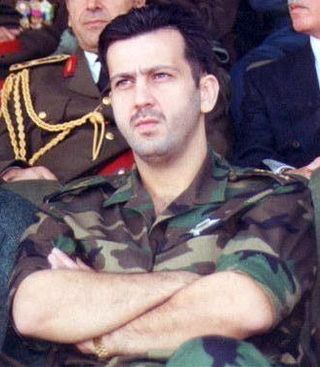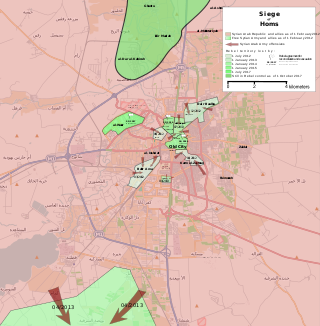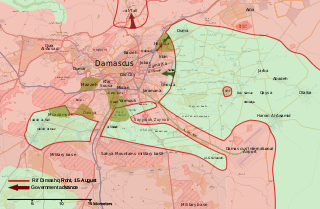
Bashar al-Assad is a Syrian politician and military officer who served as the 19th president of Syria from 2000 until his government was overthrown by Syrian rebels in December 2024. As president, Assad was the commander-in-chief of the Syrian Armed Forces and as well as the secretary-general of the Central Command of the Arab Socialist Ba'ath Party. He is the son of Hafez al-Assad, who was the president from 1971 until his death in 2000.

Rifaat Ali al-Assad, known as the 'Butcher of Hama', is a Syrian former military officer and politician. He is the younger brother of the late President of Syria, Hafez al-Assad, and Jamil al-Assad, and the uncle of the former President Bashar al-Assad. He was the commanding officer of the ground operations of the 1982 Hama massacre ordered by his brother.

Major General Maher Hafez al-Assad is a Syrian former military officer who served as commander of the Syrian Army's elite 4th Armoured Division, which, together with Syria's Military Intelligence, formed the core of the country's security forces until the collapse of Al-Assad's regime in 2024. He is the younger brother of former Syrian president Bashar al-Assad, and also was a member of the Central Committee of the Syrian Ba'ath Party.

The siege of Homs was a military confrontation between the Syrian military and the Syrian opposition in the city of Homs, a major rebel stronghold during the Syrian Civil War. The siege lasted three years from May 2011 to May 2014, and ultimately resulted in an opposition withdrawal from the city.
The Rif Dimashq clashes were a series of unrests and armed clashes in and around Damascus, the capital of Syria, from November 2011 until a stalemate in March 2012. The violence was part of the wider early insurgency phase of the Syrian civil war. Large pro-government and anti-government protests took place in the suburbs and center of Damascus, with the situation escalating when members of the Free Syrian Army (FSA) started attacking military targets in November.
The following is a timeline of the Syrian Civil War from January to April 2012, during which time the spate of protests that began in January 2011 lasted into another calendar year. An Arab League monitoring mission ended in failure as Syrian troops and anti-government militants continued to do battle across the country and the Syrian government prevented foreign observers from touring active battlefields, including besieged opposition strongholds. A United Nations-backed ceasefire brokered by special envoy Kofi Annan met a similar fate, with unarmed UN peacekeepers' movements tightly controlled by the government and fighting.
The following is a timeline of the Syrian Civil War from May to August 2012. The majority of death tolls reported for each day comes from the Local Coordination Committees, an opposition activist group based in Syria, and the Syrian Observatory for Human Rights, another opposition group based in London.

War crimes in the Syrian civil war have been numerous and serious. A United Nations report published in August 2014 stated that "the conduct of the warring parties in the Syrian Arab Republic has caused civilians immeasurable suffering". Another UN report released in 2015 stated that the war has been "characterized by a complete lack of adherence to the norms of international law" and that "civilians have borne the brunt of the suffering inflicted by the warring parties". Various countries have prosecuted several war criminals for a limited number of atrocities committed during the Syrian civil war.
The Battle of Tremseh was a military confrontation between the Syrian Army and the Free Syrian Army in Tremseh, Syria, in the late hours of 12 July 2012 during the Syrian Civil War leading to the reported death of dozens of rebels, and an unknown number of civilians. On 14 July 2012, the UN observer mission issued a statement, based on the investigation by its team that went to the town, that the Syrian military mainly targeted the homes of rebels and activists, in what the BBC said was a contradiction of the initial opposition claims of a civilian massacre. They said that the number of casualties was unclear and added that they intend to return to the town to continue their investigation.
Tadamon is a neighborhood and district of the al-Midan municipality of Damascus, Syria. The neighborhood has been active in the Syrian civil war.

The Battle of Damascus, also known as Operation Damascus Volcano, started on 15 July 2012 during the Syrian civil war. It is unclear who started the battle. Thousands of rebels infiltrated Damascus from the surrounding countryside. Following this, according to some reports, the opposition forces launched an operation to capture the capital, while according to other reports, the military learned of the large-scale rebel operation beforehand and made a preemptive strike. Some reports even suggested the rebels launched the operation prematurely due to their plans being discovered by the security forces.
This page provides a map and a list of cities and towns during the Syrian civil war.

The Rif Dimashq offensive was a Syrian Army offensive in the Rif Dimashq Governorate during August–October 2012, as part of the Syrian Civil War.
The Darayya massacre was a massacre carried out by Syrian government forces of Bashar al-Assad that occurred between 20 and 25 August 2012 in the town of Darayya in the Rif Dimashq province of Syria, during the Syrian civil war.
The siege of Daraa occurred within the context of the 2011 Arab Spring protests in Syria, in which Daraa was the center of unrest. On 25 April 2011, the Syrian Army began a ten-day siege of the city, an operation that helped escalate the uprising into an armed rebellion and subsequent civil war.

The Syrian Revolution, also known as the Syrian Revolution of Dignity and the Syrian Intifada, was a series of mass protests and civilian uprisings throughout Syria – with a subsequent violent reaction by Ba'athist Syria – lasting from February 2011 to December 2024 as part of the greater Arab Spring in the Arab world. The revolution, which demanded the end of the decades-long Assad family rule, began as minor demonstrations during January 2011 and transformed into large nation-wide protests in March. The uprising was marked by mass protests against the Ba'athist dictatorship of president Bashar al-Assad meeting police and military violence, massive arrests and a brutal crackdown, resulting in hundreds of thousands of deaths and tens of thousands wounded. 13 years after the start of the revolution, the Assad regime fell in 2024 after a series of rebel offensives.

The Ghouta chemical attack was a chemical attack carried out by the forces of Syrian President Bashar al-Assad, in the early hours of 21 August 2013 in Ghouta, Syria during the Syrian civil war. Two opposition-controlled areas in the suburbs around Damascus were struck by rockets containing the chemical agent sarin. Estimates of the death toll range from at least 281 people to 1,729. The attack was the deadliest use of chemical weapons since the Iran–Iraq War.

The Southern Damascus offensive began on 19 April 2018 when the Syrian Armed Forces began to clear an enclave held by the Islamic State of Iraq and the Levant (ISIL) in southern Damascus in the Yarmouk Camp.
A number of mass graves were uncovered after the fall of the Assad regime in December 2024. The primary site was located in al-Qutayfah, approximately 37 km north of Damascus, with additional mass graves discovered throughout the southern Damascus countryside and in southern Syria. The primary al-Qutayfah site was predicted by investigators to contain the human remains of at least 100,000 people who had been systematically and extrajudicially killed.









